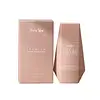What's inside
What's inside
 Key Ingredients
Key Ingredients

 Benefits
Benefits

 Concerns
Concerns

 Ingredients Side-by-side
Ingredients Side-by-side

Dicaprylyl Carbonate
EmollientTitanium Dioxide
Cosmetic ColorantCoco-Caprylate/Caprate
EmollientZea Mays Starch
AbsorbentPongamia Glabra Seed Oil
Skin ConditioningWater
Skin ConditioningPolyglyceryl-6 Stearate
EmollientPolyglyceryl-3 Polyricinoleate
EmulsifyingSorbitan Isostearate
EmulsifyingPolyglyceryl-3 Diisostearate
EmulsifyingCI 77891
Cosmetic ColorantAluminum Hydroxide
EmollientArachidyl Alcohol
EmollientStearic Acid
CleansingBehenyl Alcohol
EmollientLauroyl Lysine
Skin ConditioningCI 77492
Cosmetic ColorantArachidyl Glucoside
EmulsifyingSodium Benzoate
MaskingPolyglyceryl-6 Behenate
Emulsion StabilisingSorbitan Caprylate
EmulsifyingPotassium Sorbate
PreservativeMica
Cosmetic ColorantSesamum Indicum Seed Oil
EmollientRosa Damascena Flower Water
MaskingCI 77491
Cosmetic ColorantBisabolol
MaskingAloe Barbadensis Leaf Powder
Skin ConditioningHelianthus Annuus Hybrid Oil
EmollientSodium Lauroyl Glutamate
Olea Europaea Fruit Oil
MaskingLysine
Skin ConditioningMagnesium Chloride
Propolis Extract
Skin ConditioningPollen Extract
EmollientCitric Acid
BufferingCurcuma Longa Root Extract
MaskingDicaprylyl Carbonate, Titanium Dioxide, Coco-Caprylate/Caprate, Zea Mays Starch, Pongamia Glabra Seed Oil, Water, Polyglyceryl-6 Stearate, Polyglyceryl-3 Polyricinoleate, Sorbitan Isostearate, Polyglyceryl-3 Diisostearate, CI 77891, Aluminum Hydroxide, Arachidyl Alcohol, Stearic Acid, Behenyl Alcohol, Lauroyl Lysine, CI 77492, Arachidyl Glucoside, Sodium Benzoate, Polyglyceryl-6 Behenate, Sorbitan Caprylate, Potassium Sorbate, Mica, Sesamum Indicum Seed Oil, Rosa Damascena Flower Water, CI 77491, Bisabolol, Aloe Barbadensis Leaf Powder, Helianthus Annuus Hybrid Oil, Sodium Lauroyl Glutamate, Olea Europaea Fruit Oil, Lysine, Magnesium Chloride, Propolis Extract, Pollen Extract, Citric Acid, Curcuma Longa Root Extract
Water
Skin ConditioningIsododecane
EmollientPolysorbate 20
EmulsifyingButylene Glycol
HumectantSodium Acrylates/Beheneth-25 Methacrylate Crosspolymer
Skin ConditioningMethyl Methacrylate Crosspolymer
Hydrogenated Polydecene
EmollientLauryl Glucoside
CleansingDimethicone
EmollientTrimethylsiloxysilicate
EmollientEthylhexyl Methoxycinnamate
UV AbsorberTitanium Dioxide
Cosmetic ColorantTriethoxycaprylylsilane
PEG-20 Methyl Glucose Sesquistearate
EmulsifyingPolyhydroxystearic Acid
EmulsifyingNeopentyl Glycol Diethylhexanoate
EmollientPhenoxyethanol
PreservativeCI 77492
Cosmetic ColorantTriethanolamine
BufferingOctyldodecanol
EmollientEchium Plantagineum Seed Oil
Skin ConditioningHelianthus Annuus Seed Oil
EmollientCardiospermum Halicacabum Seed Extract
AntimicrobialCardiospermum Halicacabum Flower/Leaf/Vine Extract
Skin ConditioningNelumbo Nucifera Leaf Extract
Skin ConditioningAcrylates/C10-30 Alkyl Acrylate Crosspolymer
Emulsion StabilisingPEG-240
HumectantEthyl Ether
SolventSphingomonas Ferment Extract
Skin ConditioningDisodium EDTA
Water, Isododecane, Polysorbate 20, Butylene Glycol, Sodium Acrylates/Beheneth-25 Methacrylate Crosspolymer, Methyl Methacrylate Crosspolymer, Hydrogenated Polydecene, Lauryl Glucoside, Dimethicone, Trimethylsiloxysilicate, Ethylhexyl Methoxycinnamate, Titanium Dioxide, Triethoxycaprylylsilane, PEG-20 Methyl Glucose Sesquistearate, Polyhydroxystearic Acid, Neopentyl Glycol Diethylhexanoate, Phenoxyethanol, CI 77492, Triethanolamine, Octyldodecanol, Echium Plantagineum Seed Oil, Helianthus Annuus Seed Oil, Cardiospermum Halicacabum Seed Extract, Cardiospermum Halicacabum Flower/Leaf/Vine Extract, Nelumbo Nucifera Leaf Extract, Acrylates/C10-30 Alkyl Acrylate Crosspolymer, PEG-240, Ethyl Ether, Sphingomonas Ferment Extract, Disodium EDTA
Ingredients Explained
These ingredients are found in both products.
Ingredients higher up in an ingredient list are typically present in a larger amount.
Ci 77492 is also hydrated iron III oxide. It's sole purpose is to give a yellow hue to products.
Iron III oxides are classified as inorganic chemicals for coloring.
Synthetically created Ci 77492 is considered safer than those naturally found. This is because the synthetically created version may contain less impurities. Iron oxides are generally non-toxic and non-allergenic.
Learn more about CI 77492Titanium dioxide is a mineral UV filter widely used in sunscreens and cosmetics.
It is one of only two UV filters officially classified as “mineral” by regulatory agencies, the other being zinc oxide.
Titanium dioxide provides broad-spectrum protection mostly in the UVB and UVAII range, with some protection in the UVAI range.
While its UVA protection isn’t as strong as zinc oxide’s, the difference is minor.
A common myth is that mineral UV filters reflect UV light. However, modern research shows titanium dioxide absorbs UV radiation like chemical filters (~95% absorption & 5% reflection).
Thanks to its non-irritating nature, titanium dioxide is suitable for sensitive, acne-prone, or redness-prone skin. It is unlikely to cause "eye sting" like other sunscreen ingredients.
A major drawback of this ingredient is its white cast and thick texture. This is why mineral sunscreens often leave a white cast and are less cosmetically elegant than chemical/hybrid sunscreens.
To improve white cast and spreadability, micronized or nano-sized titanium dioxide is often used.
There are ongoing concerns surrounding nano-titanium oxide's impact on marine ecosystems.
There is no conclusive evidence that any form of titanium oxide (or any other sunscreen ingredients) will cause harm to marine ecosystems or coral reefs. The science is still developing but many consumers are keeping a close eye on this issue.
Please note, many destinations have reef-safety sunscreen rules. For instance, the U.S. Virgin Islands advises all visitors to use non-nano mineral sunscreens.
Nano mineral sunscreens once raised safety concerns about absorption into skin.
Extensive research has shown that they do not penetrate healthy or damaged skin; they remain safely on the surface and the top layer of dead skin (stratum corneum).
You'll likely find titanium dioxide bundled with alumina, silica, or dimethicone. These ingredients help make titanium dioxide highly photostable; this prevents it from interacting with other formula components under UV light.
Learn more about Titanium DioxideWater. It's the most common cosmetic ingredient of all. You'll usually see it at the top of ingredient lists, meaning that it makes up the largest part of the product.
So why is it so popular? Water most often acts as a solvent - this means that it helps dissolve other ingredients into the formulation.
You'll also recognize water as that liquid we all need to stay alive. If you see this, drink a glass of water. Stay hydrated!
Learn more about Water